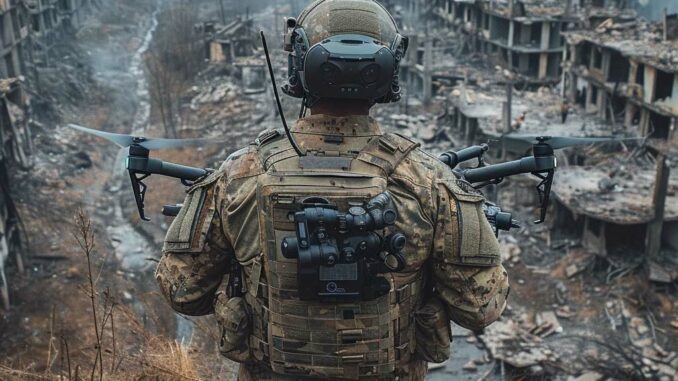
Discover how artificial intelligence is being deployed in Ukraine for autonomous navigation, target identification and more, with tactical and strategic implications.
The conflict in Ukraine is proving to be fertile ground for the implementation and development of artificial intelligence (AI) in a combat context. This phenomenon merits detailed analysis to understand both the immediate practical applications and the long-term implications of these technologies in warfare.

Using AI for navigation and target engagement
Drones, mainly small ones mass-produced by volunteers and small companies, illustrate one of the most widespread applications of AI in Ukraine. The integration of AI enables these drones to navigate and engage targets without relying on satellite navigation signals, which are often jammed by Russian forces. These electronic warfare systems, deployed on the front line, attempt to neutralize opposing sensors and communications, making autonomous AI navigation a strategic necessity.
What’s more, both Russia and Ukraine have developed algorithms to improve the accuracy of their drone strikes. For example, the Ukrainian Saker drone uses AI to locate and identify potential targets, increasing the effectiveness and accuracy of engagements.
The impact of AI on defense systems
AI has also found its way into air defense systems. One notable example is Ukraine’s development of the Zvook application, which uses AI to detect the sounds of Russian cruise missiles and provide precise indications of their trajectory. This enables better allocation of radars and defense systems, optimizing air coverage without creating vulnerable zones.
In Russia, the S-350 defense system has demonstrated the ability to engage autonomously thanks to AI. This technology could enable a fusion of sensory data, improving recognition and response to airborne threats, potentially surpassing human capabilities in terms of speed and accuracy.
Potential consequences of AI in a military context
The use of AI in the military context raises important ethical and strategic questions. While on the one hand, AI can significantly increase the effectiveness of military operations, it can also lead to an escalation of violence, algorithmic errors in distinguishing between military and civilian targets, and a technologically advanced arms race. These risks need to be carefully assessed and managed to avoid disastrous humanitarian and security consequences.
Advantages and disadvantages of AI in the ukraine conflict
The advantages of using AI in a war context include increased accuracy and greater resilience to electronic countermeasures. However, the challenges are not negligible, particularly in terms of dependence on technologies that can be compromised or hijacked. In addition, the speed of technological development and the need for continuous adaptation pose challenges in terms of reliability and security.

Current developments in AI in Ukraine offer us a glimpse of what the future of technological warfare could hold. However, these advances must be observed with caution and responsibility, given the multiple strategic, ethical and security implications they engender. The next steps in this field will be crucial in defining the frameworks for acceptable and effective use of AI in future conflicts.
War Wings Daily is an independant magazine.